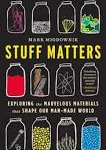 Mark Miodownik opens his entertaining and interesting book on materials science with a compelling anecdote: when he was a teenager, he was slashed with a steel razor during a mugging. At the emergency room, Miodownik relates, he was riveted by the staple holding two pages of a form together. It was his first encounter with the idea that a material, in this case steel, can have so many different uses. Then he noticed it everywhere: in the tip of the ballpoint pen, forming the body of the family’s car, and at the table – utensils are made of stainless steel. Miodownik grew up to be a materials scientist, and a good writer. The world is a better place for it, and so are we. “Stuff Matters” is a fascinating exploration of the forms, uses, evolution, and underlying structures of things – plates, tables, paper – we take for granted every day.
Mark Miodownik opens his entertaining and interesting book on materials science with a compelling anecdote: when he was a teenager, he was slashed with a steel razor during a mugging. At the emergency room, Miodownik relates, he was riveted by the staple holding two pages of a form together. It was his first encounter with the idea that a material, in this case steel, can have so many different uses. Then he noticed it everywhere: in the tip of the ballpoint pen, forming the body of the family’s car, and at the table – utensils are made of stainless steel. Miodownik grew up to be a materials scientist, and a good writer. The world is a better place for it, and so are we. “Stuff Matters” is a fascinating exploration of the forms, uses, evolution, and underlying structures of things – plates, tables, paper – we take for granted every day.
A photograph of Miodownik sitting on his roof deck at a table with a book and a cup of – perhaps it’s coffee? – provides the scaffolding for the book. Each chapter dissects an element (of the photograph, not – necessarily – a chemical element). The first chapter, Indomitable (it’s titled, like the rest, with an abstraction) discusses steel: where it comes from, its shape, and why it bends sometimes (think of a paper clip) while in other places it holds up buildings and bridges. One reason is dislocations: defects in the metal’s crystals that allow the metal crystals to change shape. Another is the content. Steel is an alloy of iron and carbon, but the proportions have to be just right: too much carbon and the steel becomes brittle. Miodownik carries the evolutionary tale from the Stone Age to the development of stainless steel (a layer of chromium oxide provides the protection).
Later chapters cover paper (“Trusted”), concrete (“Fundamental” and fascinating, especially Miodownik’s discussion of self-healing concrete and concrete cloth), plastic (“Imaginative”), glass (“Invisible”) and carbon (“Unbreakable”). Perhaps my favorite is about chocolate (“Delicious,” obviously). It’s as technically complex as steel or concrete, says Miodownik, and has taken several centuries to master.
Through sheer ingenuity, we have found a way to turn an unpromising tropical rainforest nut that tastes revolting into a cold, dark brittle solid designed for one purpose only: to melt in your mouth, flood your senses with warm, fragrant, bittersweet flavors, and ignite the pleasure centers of the brain. Despite our scientific understanding, words or formulae are not enough to describe it. It’s as close as we get, I would say, to a material poem. . .
There’s a subtle educational component underway here as well, slipped in the way some mothers slip vegetables into their children’s food. “The central idea behind materials science is that changes at these invisibly small scales impact a material’s behavior at the human scale.” In his final chapter, “Synthesis,” Miodownik ties the chemistry, physics, technology and philosophy together and compares animate and inanimate objects on a scale that moves from the human to the atomic. “[M]aterials are, in fact, composed of many different entities that combine to form the whole, and these different entities reveal themselves at different scales.” We can see tissues, gels, fibers, fabrics, and even crystals but not atoms or molecules. Yet by manipulating what we can see, we affect and change what we can’t. It’s a powerful lesson, and metaphor. Do you agree? Let us know your thoughts in the comments.
I don’t normally link to the trailers for the books I review, but Miodownik’s excitement is quite entertaining and adds a touch of whimsy to the book. You can view it here.
Have a book you want me to know about? Email me at asbowie@gmail.com. I also blog about metrics at asbowie.blogspot.com.


